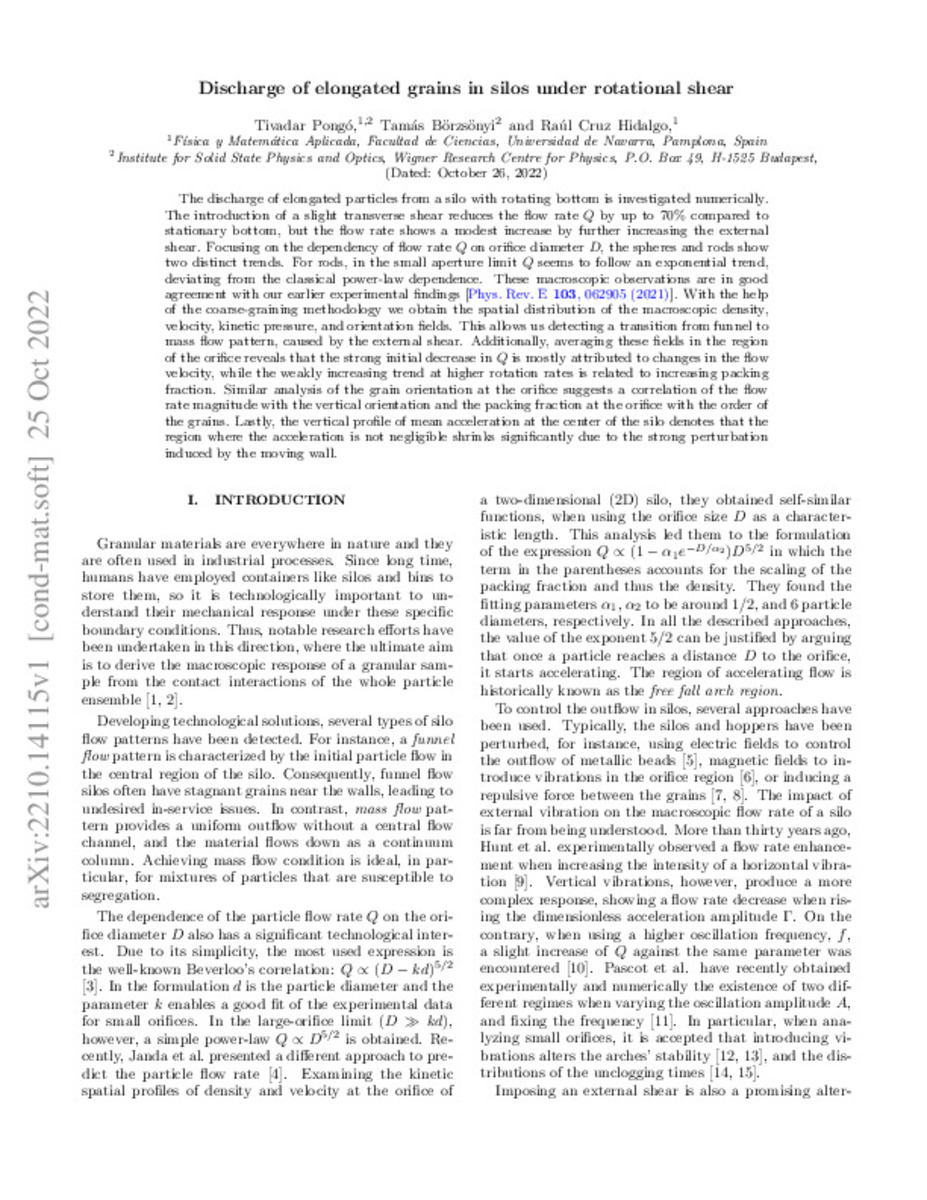Full metadata record
| DC Field | Value | Language |
|---|---|---|
| dc.creator | Pongó, T. (Tivadar) | - |
| dc.creator | Börzsönyi, T. (Tamás) | - |
| dc.creator | Cruz-Hidalgo, R. (Raúl) | - |
| dc.date.accessioned | 2023-01-13T14:20:11Z | - |
| dc.date.available | 2023-01-13T14:20:11Z | - |
| dc.date.issued | 2022 | - |
| dc.identifier.citation | Pongó, T. (Tivadar); Börzsönyi, T. (Tamás); Cruz-Hidalgo, R. (Raúl). "Discharge of elongated grains in silos under rotational shear". Physical Review E. 106, 2022, 034904 | es |
| dc.identifier.uri | https://hdl.handle.net/10171/64986 | - |
| dc.description.abstract | The discharge of elongated particles from a silo with rotating bottom is investigated numerically. The introduction of a slight transverse shear reduces the flow rate Q by up to 70% compared with stationary bottom, but the flow rate shows a modest increase by further increasing the external shear. Focusing on the dependency of flow rate Q on orifice diameter D, the spheres and rods show two distinct trends. For rods, in the small-aperture limit Q seems to follow an exponential trend, deviating from the classical power-law dependence. These macroscopic observations are in good agreement with our earlier experimental findings [Phys. Rev. E 103, 062905 (2021)]. With the help of the coarse-graining methodology we obtain the spatial distribution of the macroscopic density, velocity, kinetic pressure, and orientation fields. This allows us detecting a transition from funnel to mass flow pattern caused by the external shear. Additionally, averaging these fields in the region of the orifice reveals that the strong initial decrease in Q is mostly attributed to changes in the flow velocity, while the weakly increasing trend at higher rotation rates is related to increasing packing fraction. Similar analysis of the grain orientation at the orifice suggests a correlation of the flow rate magnitude with the vertical orientation and the packing fraction at the orifice with the order of the grains. Lastly, the vertical profile of mean acceleration at the center of the silo denotes that the region where the acceleration is not negligible shrinks significantly due to the strong perturbation induced by the moving wall. | es_ES |
| dc.description.sponsorship | European Union’s Horizon 2020 Marie Skłodowska-Curie grant “CALIPER” (No. 812638). R.C. Hidalgo acknowledges the Ministerio de Ciencia e Innovación (Spanish Government) Grant PID2020-114839GB-I00 funded by MCIN/AEI/10.13039/501100011033. | es_ES |
| dc.language.iso | eng | es_ES |
| dc.relation | info:eu-repo/grantAgreement/AEI/Proyectos I+D /PID2020-114839GB-I00/ES/COMPORTAMIENTO COLECTIVO EMERGENTE EN SISTEMAS DE MUCHAS PARTICULAS | es_ES |
| dc.rights | info:eu-repo/semantics/openAccess | es_ES |
| dc.title | Discharge of elongated grains in silos under rotational shear | es_ES |
| dc.type | info:eu-repo/semantics/article | es_ES |
| dc.identifier.doi | 10.1103/PhysRevE.106.034904 | - |
| dadun.citation.publicationName | Physical Review E | es_ES |
| dadun.citation.startingPage | 034904 | es_ES |
| dadun.citation.volume | 106 | es_ES |
Files in This Item:
Statistics and impact
Items in Dadun are protected by copyright, with all rights reserved, unless otherwise indicated.






